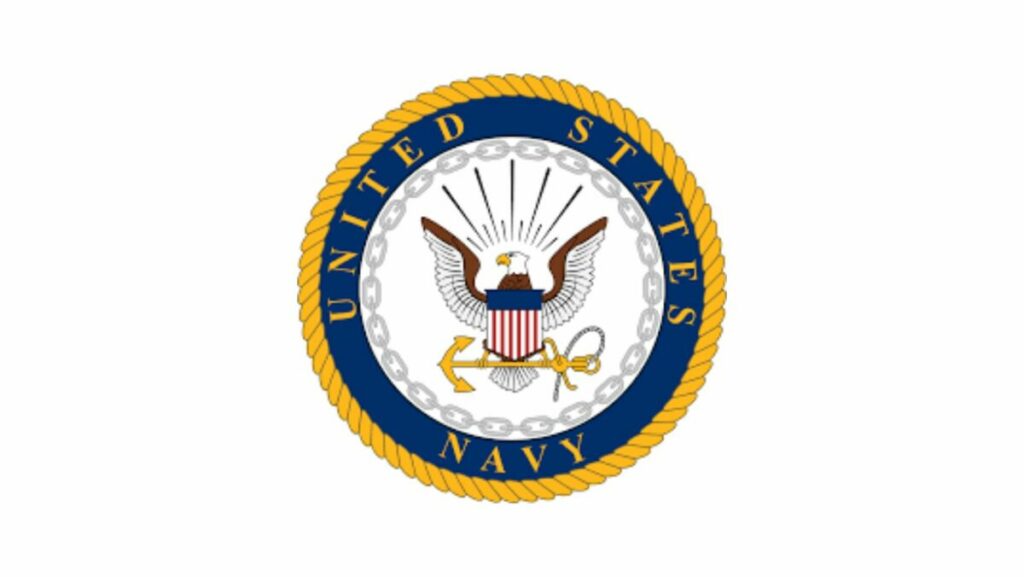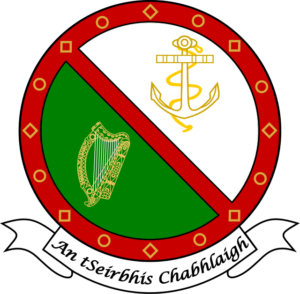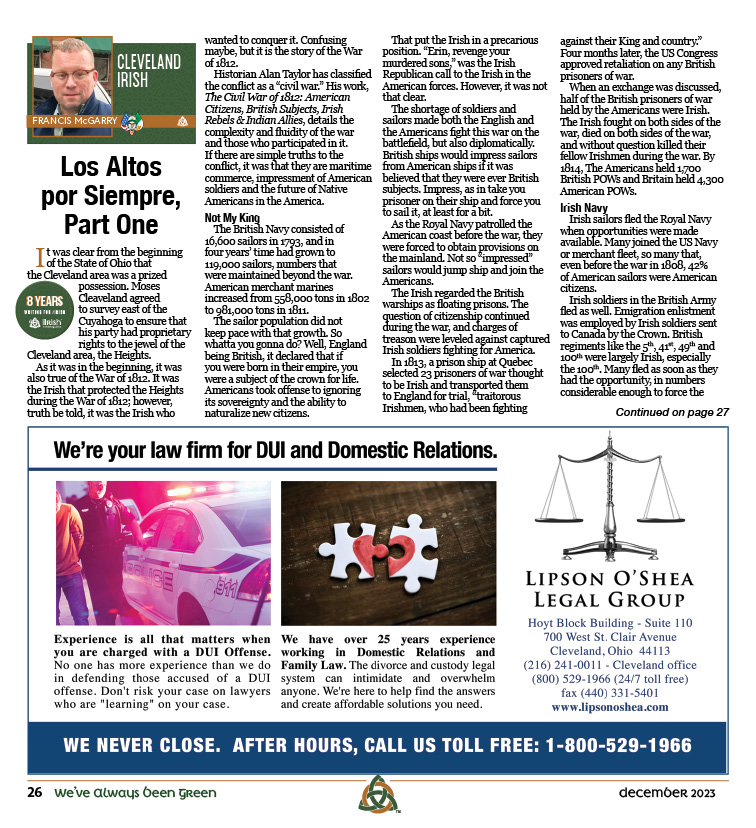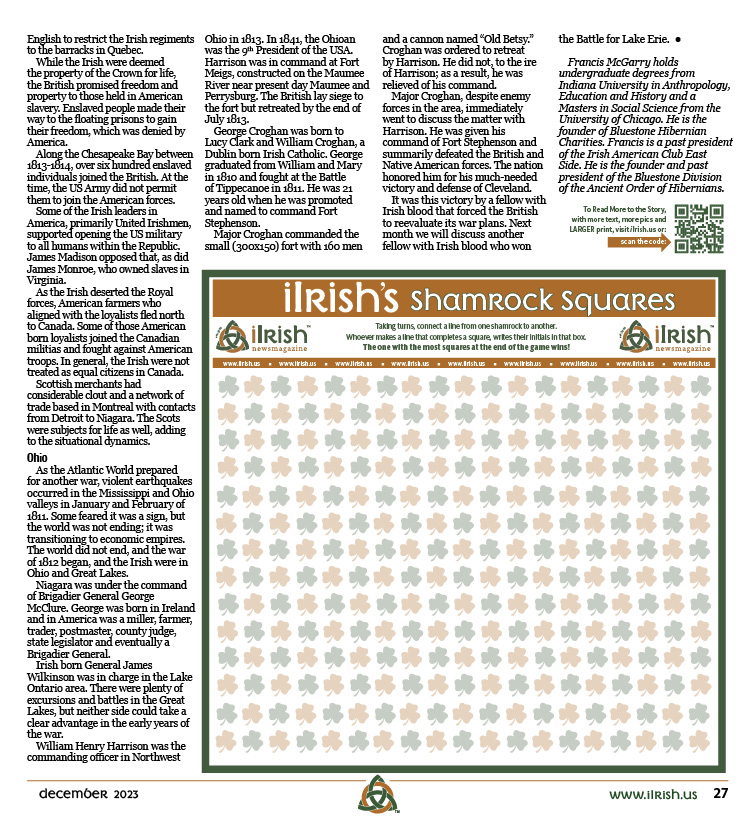
It was clear from the beginning of the State of Ohio that the Cleveland area was a prized possession. Moses Cleaveland agreed to survey east of the Cuyahoga to ensure that his party had proprietary rights to the jewel of the Cleveland area, the Heights.
As it was in the beginning, it was also true of the War of 1812. It was the Irish that protected the Heights during the War of 1812; however, truth be told, it was the Irish who wanted to conquer it. Confusing maybe, but it is the story of the War of 1812.
Historian Alan Taylor has classified the conflict as a “civil war.” His work, The Civil War of 1812: American Citizens, British Subjects, Irish Rebels & Indian Allies, details the complexity and fluidity of the war and those who participated in it. If there are simple truths to the conflict, it was that they are maritime commerce, impressment of American soldiers and the future of Native Americans in the America.
The British Navy consisted of 16,600 sailors in 1793, and in four years’ time had grown to 119,000 sailors, numbers that were maintained beyond the war. American merchant marines increased from 558,000 tons in 1802 to 981,000 tons in 1811.
The sailor population did not keep pace with that growth. So whatta you gonna do? Well, England being British, it declared that if you were born in their empire, you were a subject of the crown for life. Americans took offense to ignoring its sovereignty and the ability to naturalize new citizens.
That put the Irish in a precarious position. “Erin, revenge your murdered sons,” was the Irish Republican call to the Irish in the American forces. However, it was not that clear.
The shortage of soldiers and sailors made both the English and the Americans fight this war on the battlefield, but also diplomatically. British ships would impress sailors from American ships if it was believed that they were ever British subjects. Impress, as in take you prisoner on their ship and force you to sail it, at least for a bit.
As the Royal Navy patrolled the American coast before the war, they were forced to obtain provisions on the mainland. Not so “impressed” sailors would jump ship and join the Americans.
The Irish regarded the British warships as floating prisons. The question of citizenship continued during the war, and charges of treason were leveled against captured Irish soldiers fighting for America.
In 1813, a prison ship at Quebec selected 23 prisoners of war thought to be Irish and transported them to England for trial, “traitorous Irishmen, who had been fighting against their King and country.” Four months later, the US Congress approved retaliation on any British prisoners of war.
When an exchange was discussed, half of the British prisoners of war held by the Americans were Irish. The Irish fought on both sides of the war, died on both sides of the war, and without question killed their fellow Irishmen during the war. By 1814, The Americans held 1,700 British POWs and Britain held 4,300 American POWs.

Irish sailors fled the Royal Navy when opportunities were made available. Many joined the US Navy or merchant fleet, so many that, even before the war in 1808, 42% of American sailors were American citizens.
Irish soldiers in the British Army fled as well. Emigration enlistment was employed by Irish soldiers sent to Canada by the Crown. British regiments like the 5th, 41st, 49th and 100th were largely Irish, especially the 100th. Many fled as soon as they had the opportunity, in numbers considerable enough to force the English to restrict the Irish regiments to the barracks in Quebec.
While the Irish were deemed the property of the Crown for life, the British promised freedom and property to those held in American slavery. Enslaved people made their way to the floating prisons to gain their freedom, which was denied by America.
Along the Chesapeake Bay between 1813-1814, over six hundred enslaved individuals joined the British. At the time, the US Army did not permit them to join the American forces.
Some of the Irish leaders in America, primarily United Irishmen, supported opening the US military to all humans within the Republic. James Madison opposed that, as did James Monroe, who owned slaves in Virginia.
As the Irish deserted the Royal forces, American farmers who aligned with the loyalists fled north to Canada. Some of those American born loyalists joined the Canadian militias and fought against American troops. In general, the Irish were not treated as equal citizens in Canada.
Scottish merchants had considerable clout and a network of trade based in Montreal with contacts from Detroit to Niagara. The Scots were subjects for life as well, adding to the situational dynamics.
As the Atlantic World prepared for another war, violent earthquakes occurred in the Mississippi and Ohio valleys in January and February of 1811. Some feared it was a sign, but the world was not ending; it was transitioning to economic empires. The world did not end, and the war of 1812 began, and the Irish were in Ohio and Great Lakes.
Niagara was under the command of Brigadier General George McClure. George was born in Ireland and in America was a miller, farmer, trader, postmaster, county judge, state legislator and eventually a Brigadier General.
Irish born General James Wilkinson was in charge in the Lake Ontario area. There were plenty of excursions and battles in the Great Lakes, but neither side could take a clear advantage in the early years of the war.
William Henry Harrison was the commanding officer in Northwest Ohio in 1813. In 1841, the Ohioan was the 9th President of the USA. Harrison was in command at Fort Meigs, constructed on the Maumee River near present day Maumee and Perrysburg. The British lay siege to the fort but retreated by the end of July 1813.
George Croghan was born to Lucy Clark and William Croghan, a Dublin born Irish Catholic. George graduated from William and Mary in 1810 and fought at the Battle of Tippecanoe in 1811. He was 21 years old when he was promoted and named to command Fort Stephenson.
Major Croghan commanded the small (300×150) fort with 160 men and a cannon named “Old Betsy.” Croghan was ordered to retreat by Harrison. He did not, to the ire of Harrison; as a result, he was relieved of his command.
Major Croghan, despite enemy forces in the area, immediately went to discuss the matter with Harrison. He was given his command of Fort Stephenson and summarily defeated the British and Native American forces. The nation honored him for his much-needed victory and defense of Cleveland.
It was this victory by a fellow with Irish blood that forced the British to reevaluate its war plans. Next month we will discuss another fellow with Irish blood who won the Battle for Lake Erie.
Find this and Francis’s other Cleveland Irish columns and others from this month’s issue here.

*Francis McGarry holds undergraduate degrees from Indiana University in Anthropology, Education and History and a Masters in Social Science from the University of Chicago. He is the Executive Director of Bluestone Hibernian Charities and proprietor of McGarry Consulting. He is a past president of the Irish American Club East Side and the founder and past president of the Bluestone Division of the Ancient Order of Hibernians.







Monthly newsmagazine serving people of Irish descent from Cleveland to Clearwater. We cover the movers, shakers & music makers each and every month.
Since our 2006 inception, iIrish has donated more than $376,000 to local and national charities.
GET UPDATES ON THE SERIOUS & THE SHENANIGANS!